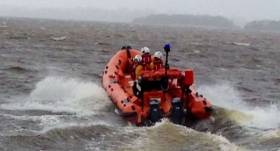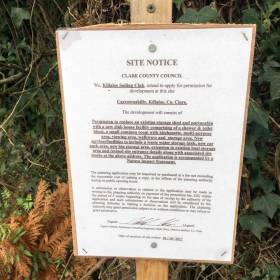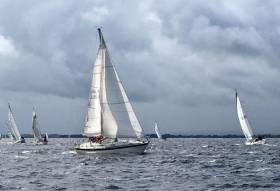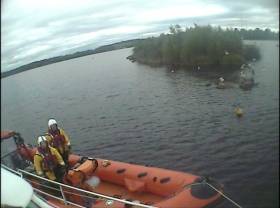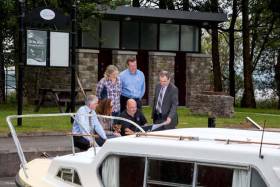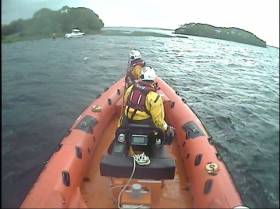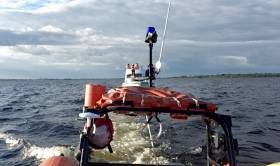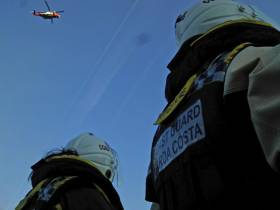Displaying items by tag: Lough Derg
RNLI On Lough Derg Respond to Vessel Reported To Be On Fire
At 2.34pm, Monday October 30, Lough Derg RNLI lifeboat launched following a request from Valentia Coast Guard to assist two people and a dog on boat a vessel reported to be on fire. The wind was south-westerly, F1 and with good visibility.
The lifeboat located the 31ft cruiser at anchor off Hare Island off the County Clare shore, the passengers and their dog were safe and unharmed. The skipper had cut his engine and dropped anchor when he noticed black smoke billowing from the engine. When the lifeboat arrived on scene, the engine was no longer issuing smoke and the situation had settled.
With an RNLI crew member on board, the cruiser with her passengers was taken under tow for the public harbour at Dromineer. As the lifeboat was towing the cruiser, volunteer crew were informed that the dog had jumped overboard. The lifeboat immediately stopped its engine and made to recover the dog from the water. However, with encouragement from his owners, the dog swam back to the casualty vessel where he was brought back on board.
After the cruiser was safely tied up alongside in Dromineer Harbour, the lifeboat returned to station and was ready for service at 5pm.
At 12.23pm on Sunday, October 29, Lough Derg RNLI Lifeboat launched following a request from Valentia Coast Guard to assist 5 people on board a 40ft cruiser aground behind Illaunmore on the north eastern shore of Lough Derg. Winds were south-westerly and F1.
The lifeboat located the vessel at 12.47pm and found all passengers to be safe and unharmed and wearing their lifejackets. The lifeboat transferred an RNLI volunteer across to the cruiser, where he inspected the boat, and once satisfied that it was not holed he prepared the boat to be taken off the rocks. However when the casualty vessel was found to be stuck fast on the rocks, the lifeboat crew decided to take the five passengers and their belongings to Dromineer. Meanwhile RNLI volunteer shore crew made arrangements to have the boat lifted off the rocks.
The lifeboat was ready for service again at 2.35pm
Pat Garland, Deputy Launching Authority at Lough Derg RNLI Lifeboat Station, advises boat users to ‘enjoy the lake, but make sure you stay on the navigation route, well clear of the shoreline’.
Killaloe Sailing Club To Seek Planning Permission For New Clubhouse
Killaloe Sailing Club in Co Clare is applying for planning permission for a new clubhouse on the shores of Lough Derg.
The site notice for the proposed development at Carrownakilly seeks permission to replace the existing storage shed and portacabin with a permanent building including shower and lavatory facilities, a small kitchen, assembly rooms and storage space.
The proposal also includes new car parking, bin storage and a waste water tank, a revised site entrance and an extension of the existing boat storage area.
Next steps for the Co Clare club will involve fundraising efforts to cover the costs of the new facilities.
Great to see the site notice up @Irish_Sailing @AfloatMagazine . All we need now is to raise money to fund it @rwycikilrush @cullaunsailing pic.twitter.com/wGWocAqnR1
— Killaloesailingclub (@KillaloeSC) October 14, 2017
LaBamba Claims Gortmore Bell Race on Lough Derg
The Gortmore Bell Race, sponsored by Union Chandlery took place this Saturday on Lough Derg with 23 boats taking part across two classes.
This is the lough's longest race in the calendar from Iniscealtra Sailing Club’s base in Mountshannon to the Gortmore mark near Portumna and home via Mountaineer rock buoy near Domineer.
Class 2 got underway first at 10:45 followed 30 min later by class 1 at 11:15 in a NW breeze which was set to increase as the morning went on. 1st around the Gortmore mark and heading for home was Serendipity helmed by Robert Bourke, first around in Class 1 was Jumping Jack Flash helmed by Dominic O’Sullivan. The breeze increased to 30–kts at times which made for exiting reaching conditions for the three SB20’s in the fleet who managed to hold they asymmetric spinny’s from Coose mark to Mountaneer bouy. Line honours was claimed by the SB20 Jumping Jack Flash followed quickly by the rest of the fleet with all boats finished by 16:40pm.
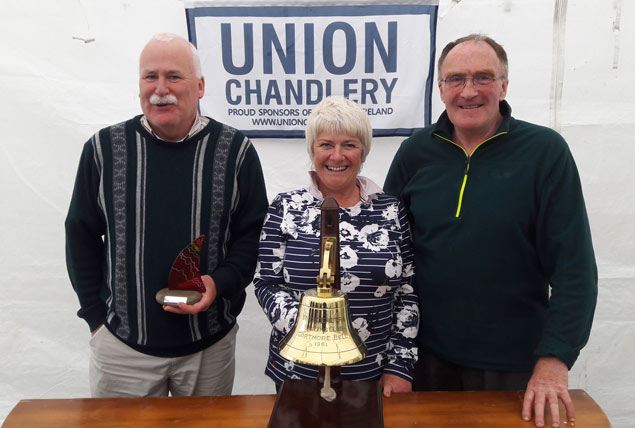 Gortmore Bell Winners 2017 – (from left to right) Sean Collins, Mary and Mike Sadlier of La Bamba
Gortmore Bell Winners 2017 – (from left to right) Sean Collins, Mary and Mike Sadlier of La Bamba
1st Place Overall and in Class 1 was LaBamba helmed by Mary Sadlier and crewed by Mike Sadlier and Sean Collins, 1st Place in Class 2 was Serendipity helmed by Robert Bourke, 1st Place in J24 fleet was Jobs for the Buoys, helmed by Barney Power and 1st place in SB20 fleet was claimed by Jonathan Foley’s Jumping Jack Flash helmed by Dominic O’Sullivan.
Full results attached below for download.
Lough Derg Lifeboat Assists Six On Grounded Cruiser
#RNLI - Lough Derg RNLI’s inshore lifeboat launched on Monday afternoon (21 August) to assist six people after their 30ft cruiser ran aground behind the Corakeen Islands near Dromineer Bay.
The lifeboat launched on request from Valentia Coast Guard with helm Eleanor Hooker, Ger Egan and Owen Cavanagh on board. Winds were south-westerly Force 3 and visibility was good.
Another motorboat had reported the vessel aground and had dropped anchor close by until the lifeboat arrived on scene.
All six passengers, four adults and two children, were found to be safe and unharmed and wearing their lifejackets.
The lifeboat transferred a crewman over to the casualty vessel, where he reassured everyone on board before he conducted checks of the vessel to ensure it was not holed.
A bridle was then set up in preparation for a tow, and the lifeboat took the boat off the rocks and out into safe water.
Following another assessment, it was found that the cruiser had suffered damage to steering and rudder. The lifeboat then took the cruiser and passengers under tow to the public harbour at Dromineer.
Pat Garland, deputy launching authority at Lough Derg RNLI lifeboat station, reminded boat users to “enjoy the lake but make sure you stay on the navigation route, well clear of the shoreline.”
New canoe facilities and services blocks have been provided at Dromaan Harbour, County Clare, as part of a regional initiative aimed at promoting water-based activities on Ireland’s third largest lake.
The Lough Derg Canoe Trail, an initiative of the Lough Derg Marketing Group and funded under the Lough Derg Stimulus Fund, aims to provides for new facilities at Killaloe and Ballycuggeran, and at Scarriff, Mountshannon and Dromaan Harbours. The design and development of the Trail project is being led by Waterways Ireland in partnership with Clare County Council, Galway County Council and Tipperary County Council.
Cllr. Pat Burke, Leas Cathaoirleach of Clare County Council, has welcomed the completion of works at Dromaan Harbour which he described as “a hidden gem” in the Lough Derg Region.
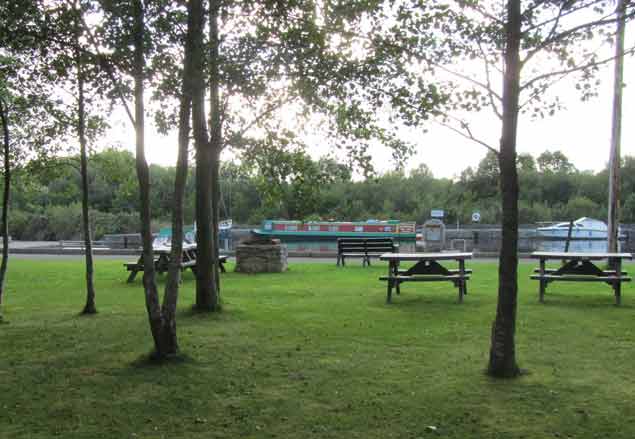 A hidden gem – and a peaceful one, too. Although only a few miles across Lough Derg from the bustle of Dromineer or Garrykennedy, and just round the corner from busy Mountshannon, Dromaan manages to be a sheltered oasis of peace and quiet
A hidden gem – and a peaceful one, too. Although only a few miles across Lough Derg from the bustle of Dromineer or Garrykennedy, and just round the corner from busy Mountshannon, Dromaan manages to be a sheltered oasis of peace and quiet
The completed works at the Clare County Council-owned harbour facility include trail information signage, a canoe storage rack and screening, and a new 3-unit service block and holding tank.
The Lough Derg Canoe Trail forms part of a wider initiative to develop and promote a Blueway on Lough Derg. Managed by a Steering Committee comprising the Lough Derg Marketing Group, Clare County Council, Tipperary County Council and Waterways Ireland, the proposed Blueway will be targeted for use by non-motorised water activity enthusiasts. Internationally, Blueways are defined by trail heads, access and egress points, and readily available trail information
Lough Derg Lifeboat Assists 12 In Two Weekend Callouts
#RNLI - At 11.36am yesrerday (Sunday August 6), Lough Derg RNLI were diverted from exercise after a motorboat fouled its propellers on a line and suffered engine failure.
The 25ft boat with six people on board was reported to be near Coolbawn, at the northeastern shore of Lough Derg.
Lifeboat helm Peter Clarke launched the inshore lifeboat with Owen Cavanagh and Kevin Dooley on board amid southwesterly winds blowing Force 5, with fair visibility but frequent heavy squalls.
The lifeboat located the stricken vessel at 11.50am. All six passengers were found to be safe and unharmed and wearing their lifejackets.
It emerged that the motorboat had fouled its propellers while towing a wakeboarder, and then suffered engine failure. The skipper had also dropped anchor to prevent being pushed onto rocks.
One of the lifeboat crew was transferred to the casualty vessel, where he cut away the lines caught around the propellers of both engines.
He set up a bridle in preparation for a tow, and after he weighed anchor, the lifeboat took the boat and her passengers under tow to Coolbawn Quay.
Liam Maloney, lifeboat operations manager at Lough Derg RNLI, advises boat users to “enjoy the lake, but make sure all your ropes are clear of your engine and carefully stowed when not in use.”
Earlier in the weekend, Valentia Coast Guard requested the lifeboat to assist six people after their 38ft cruiser ran aground at the Goat Road on the eastern shore of Lough Derg on Friday evening (4 August).
At 7.40pm, the lifeboat launched with helm Eleanor Hooker, Dean O’Sullivan and Kevin Dooley on board. Winds were westerly Force 3 and visibility was good.
The lifeboat located the cruiser inside the Goat Road and navigation buoy E. All six passengers were found to be safe and unharmed and were requested to don their lifejackets.
After checking the casualty vessel was not holed, a lifeboat crew member set up a tow line and told the passengers what to expect as the boat was taken off the rocky shelf.
The lifeboat made numerous attempts to take the cruiser off the rocks, but it was stuck fast. In the meantime, the owner of the cruiser had arranged for two marine engineers to attend the cruiser on a motorboat.
It was then decided to offload the boat’s passengers with the lifeboat to enable the engineers to attempt a refloat of the cruiser with a lighter load.
The cruiser was afloat before 9.30pm. But as night was falling, the lifeboat took the passengers across the lake to the closest harbour at Rossmore while one of the engineers helmed the cruiser.
Commenting on Friday’s callout, Maloney advises all boat users on the lake, to “bring up to date charts of the lake and plan your passage before leaving harbour, and do not to stray off the navigation route.”
#RNLI - Lough Derg RNLI’s volunteers were surprised to find a man whose cruiser had grounded near Hare Island had spent the night alone stranded in the lake as he was reluctant to call for help.
Valentia Coast Guard requested Lough Derg RNLI to investigate a report from a passing cruiser this morning (Friday 28 July) of a vessel, thought to have slipped its moorings, that was aground behind Hare Island.
At 9.15am the lifeboat crew located the 16ft cruiser in Church Bay, behind Hare Island on the Clare shore. Church Bay is known for particular hazards such as sudden shallows and rocks.
The lifeboat proceeded with caution and, when sufficiently close to the cruiser, an RNLI volunteer waded to the vessel – where a man was found on board, asleep in the cabin below.
Within half an hour the boat was off the rocks and taken under tow to the harbour at Garrykennedy.
Its skipper, who was safe and unharmed and wearing his lifejacket, told the lifeboat crew that he had been stranded on his boat since 8pm the previous evening, but was reluctant to call the rescue services, anxious not to put anyone out.
Winds overnight on Lough Derg were strong westerlies blowing Force 5 and gusting up to Force 7.
“No callout is routine — our training and experience tells us to expect the unexpected,” said Lough Derg RNLI helm Eleanor Hooker.
“We approached what we thought was an empty vessel which had slipped its moorings and found a person onboard who had spent the night alone, stranded in stormy conditions, and without help coming for them.
“The RNLI are there to answer any call for help. No lifeboat launch is ever a waste of our time or resources.”
Pat Garland, deputy launching authority with Lough Derg RNLI, added: “I would urge all boat users when is difficulty to call 999 or 112 and ask for the coastguard.
“RNLI lifeboats are launched at the request of the Irish Coast Guard, who then make the correct call on which search and rescue assets to deploy to the scene.
“We would urge the public not to delay calling for help. This could have had a very different outcome.”
On Saturday July 22, Valentia Coast Guard requested Lough Derg RNL to assist two people and their dog after their 38ft cruiser ran aground at Ryan’s Point, on the eastern shore of Lough Derg.
At 2.35pm the lifeboat was launched with helm Eleanor Hooker, Keith Brennan and Darragh Quinn on board. Winds were northeasterly, Force 2. Visibility was good.
Both passengers and their dog were found to be safe and unharmed and wearing their lifejackets. The RNLI made numerous attempts to take the cruiser off the rocks, but it was stuck fast. The RNLI volunteer crew decided to take both people and their dog to Dromineer and to arrange for the cruiser to be lifted off the rocks by a specialist crew from the local marina. They informed Valentia Coast Guard of their decision.
The lifeboat returned to station and was ready for service again at 4.32pm.
At 7.22pm, the lifeboat launched following a request from Valentia Coast Guard to assist four people in a 40ft cruiser with engine failure by the Goat Road, at the northern end of Lough Derg. At 7.40pm the lifeboat, with helm Eleanor Hooker, Owen Cavanagh and Kevin Dooley on board, located the cruiser adrift on the navigation route. The wind was northerly, F2/3.
The lifeboat took the vessel on an astern tow to Dromineer Bay, where the lifeboat volunteers changed the tow to an alongside tow before bringing the boat into Dromineer Harbour.
Once the cruiser was safely tied up alongside at Dromineer, the lifeboat returned to Station and was read for service again at 9.07pm
Brendan O’Brien, Deputy Launching Authority at Lough Derg RNLI Lifeboat Station, advises all boat users on the lake, to ‘bring charts of the lake in addition to electronic systems of navigation, and plan a safe passage before leaving harbour’.
#Rescue - A cruiser with four on board was aided by the Irish Coast Guard after it suffered engine trouble and snapped its anchor line in poor weather on Lough Derg yesterday (Sunday 2 July).
As BreakingNews.ie reports, the alarm was raised around 1pm yesterday after the 33ft cruiser heading south from Portumna was reported in difficultly near Terryglass.
Killaloe’s coastguard unit, who were training in the area at the time, responded to the distress call and took the cruiser under tow to the safety of Terryglass Harbour before it could run around or become a danger to other vessels.
The incident comes a month after Lough Derg RNLI launched to two yachts that grounded at either end of the lough, as previously reported on Afloat.ie.
#RNLI - Lough Derg RNLI rescued three people from two grounded yachts in two separate callouts on Sunday (4 June).
At 11.22am, as the lifeboat crew were returning to station following morning exercise, they were requested by Valentia Coast Guard to assist two people on a 22ft yacht aground 1km above Killaloe on the Tipperary shore, at the southern end of Lough Derg.
The lifeboat responded immediately with helm Eleanor Hooker, Darragh Quinn and Barry Morkan on board, and was alongside the casualty vessel at 11.48am. Visibility was good with winds at a westerly Force 3-4.
The yacht was under sail when it was pushed ashore by a severe gust. Both passengers were found to be safe and unharmed and wearing their lifejackets.
The RNLI volunteers checked the boat and when satisfied that it was not holed, set up bridle and tow to take it safely off the rocks.
Before removing the tow, the lifeboat crew made certain that the boat was not taking any water and the rudder was not damaged. The yacht then made way using its outboard motor to its berth at Killaloe.
The second callout came later that afternoon at 3.50pm, following a distress call for assistance on the emergency VHF Channel 16.
Valentia Coast Guard requested Lough Derg RNLI to assist a lone yachtsman whose yacht was aground by Stick Rock, at the northern end of Lough Derg on the Co Clare shore.
At 4.04pm, the lifeboat launched with helm Eleanor Hooker, Ger Egan and Kevin Dooley on board. Winds were south-westerly, visibility was fair to poor with low clouds, rain and frequent squalls.
At 4.38pm, the lifeboat located the yacht at Stick Rock. The yachtsman was safe and unharmed and wearing his lifejacket. An RNLI crew member was transferred to the yacht to assess it for any damage before it was lifted off the rock and back in safe water 11 minutes later.
With the skipper unable to get his inboard engine started, the lifeboat escorted the boat under sail to Cloondavaun Bay, where the RNLI crew took the yacht under tow through the narrow channel to its berth.
Brendan O’Brien, deputy launching authority at Lough Derg RNLI, reminded boat users: “Check weather conditions on the lake before going afloat and to carry up to date charts of the lake.”


























